Scaling mountainous terrain or keeping an eye out for grizzly bears and moose while wading through the flowing rivers of the Yukon may not seem typical of academic work. But these were only some of the many challenging conditions McGill researchers endured while conducting a recent study looking at oxygen levels on Earth before they started rising roughly 2.43 billion years ago.
Maxwell Letche, a postdoctoral researcher in Earth sciences at McGill and lead author of the study, explained that the redox state of iron-rich sedimentary rocks can tell us about atmospheric composition long ago.
“When the earth first formed, we didn’t have photosynthesizers around, so the atmosphere must have been anoxic,” Letche said in an interview with The McGill Tribune. “We’re trying to look at the transition from no oxygen to lots of oxygen on the earth.”
Nearly all of the life on Earth owes its existence in part to oxygen. If a human doesn’t receive enough oxygen, they will die. If the grizzly bear currently stalking that human doesn’t receive enough oxygen, it will also die. Understanding the oxygen levels at different points in the Earth’s history, coupled with the evolutionary timeline of life on Earth, provides valuable insight into the development of life as a whole.
“When you’re looking at sedimentary rock, you’re looking at a collection of minerals and rocks that have accumulated in a depositional environment that has been influenced by a number of different surface processes, like weathering, transport, and changes that can occur as that sediment was converted […] into rock,” Letche said.
This aggregated collection allowed Letche and his team to simultaneously study a variety of different minerals and their reaction to oxygen levels at their time of formation. Such an analysis required gathering a variety of samples, which is why Letche found himself in remote, untarnished parts of the world such as the Eastern Yukon.
The study gives us a more accurate understanding of the relationship between oxygen levels across the planet and the formation of early life forms. One finding was that the Earth experienced a period of low atmospheric oxygen levels. Previously, scientists had assumed that the Earth either had no oxygen or a large abundance of oxygen later on, in response to photosynthesis.
“What we argue is […] if the earth was capable of maintaining a small but non-zero level of oxygen, this could be completely consumed by surface reactions [and] these oxygen levels could be below what is detectable by telescopes,” Letche said. “Another potential suggestion being made is we could instead look for ozone. We only need a small amount of oxygen in the atmosphere in order to produce ozone.”
As ozone is more detectable than oxygen, searching for this compound could allow scientists to screen more planets for potential signs of life. Understanding of the relationship between the development of life on Earth could even prove useful in the ongoing search for life on other planets.






